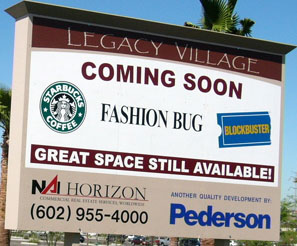|
|
|
| Chris Brown's Project Pages
|
Changing Business in South Phoenix By Chris Brown Driving through South Phoenix, it is impossible not to notice change. New homes and businesses are being built everywhere, as older buildings and long-time residents are pushed elsewhere. Big business, including stores such as Target, Ross, and CVS, has not yet taken over the area, but large shopping centers and stand-alone buildings are quickly entering South Mountain Village. The juxtaposition of new and old business is a sight that will probably not last long in a quickly changing urban landscape. While it is present, however, a look into the changes occurring and lives affected can help explain what is happening in the area, giving a better understanding of the South Mountain Village of the future.
On the corner of Baseline and 16th street stands an independently owned and operated gas station and convenience store. Across the street are a brand new Texaco and a CVS pharmacy under construction. This image is a perfect example of the temporary cohabitation of new and old in South Phoenix, and provides a chance to explore change. A quick talk with the gas and convenience store owner reveals some of the attitudes of the many business owners faced with rapid growth and modern business’ encroachment. The owner professed two sharply contrasting views on the new South Phoenix. While he was excited about all the new homes and residential growth that is sure to provide more customers, he recognized that businesses such as Texaco and CVS could take most of those new customers, and some of his old ones. When asked directly about the new stores, he shrugged and expressed a powerless sentiment: “What can I do?” New stores are already established just down the street, on Baseline and 24th Street. A new Target and Ross accompany chain restaurants and “quality” retail stores in a large strip mall indicative of what is on its way to South Phoenix. In an article in the Arizona Republic in March of 2004, Carol Sowers examines the attitudes of new and old residents of South Phoenix, relating the issue directly to the influx of big business. Noting that the new homes being built in the area bring people with higher incomes, Sowers quotes a member of the South Mountain Village Planning Committee, verbalizing the work being done to “have quality retail to go with quality homes.” This attitude undoubtedly serves well new residents with bulging wallets and a taste for corporate America, but denotes the inevitable destruction of businesses such as the independent gas station and convenience store further down Baseline. With the quickly changing landscape, it is important to ask who is being helped and who is being hurt by all the development? A visit to the new shopping center mentioned in Sowers’ article provides some insight. While nearer to the edge of South Phoenix, the stores are sandwiched in between brand new housing developments and much older homes. Ethnic minorities still make up a large part of the population of the area, just like the rest of South Phoenix, but a look at the customers in the new stores and restaurants reveals a different story. Eating lunch in a Subway restaurant, only a few of the many customers present for the lunch rush were minorities. Most were white, middle class people, perhaps representing the new population entering South Mountain Village to live in those new housing communities. Older stores just down the street, not yet giving way to big business, seem to have more minorities walking through the door than these new “quality” retail sites. In addition to exploring the patrons of South Phoenix businesses, an examination of the employees of new and old businesses might add some depth to this discussion. As Elizabeth Burns and Patricia Gober observe in “Job Linkages in Inner-City Phoenix,” “most jobs in inner-city Phoenix do not translate into employment opportunities for inner-city residents.” (21) It is not clear if new business development in South Mountain Village is expected by politicians and business owners to help alleviate the employment problems of the area, but evidence from Burns and Gober would suggest that this side affect, regardless of intent, should not be expected. This means that not only are the patrons of new business development, as observed in a minimal study by myself, possibly representative of a new influx of middle-class white people, but the employment benefits of the businesses might also be more prominently enjoyed by such new residents. With new businesses catering to and employing new, white, middle class residents, what is to happen to the older businesses and residents who find themselves in the way of “progress?” In five years we may have an answer to that question. For now, all we can do is show the changes that are occurring, and hope that in a new urban landscape there is still room for some of the rich culture that has made South Phoenix unique for decades.
|

